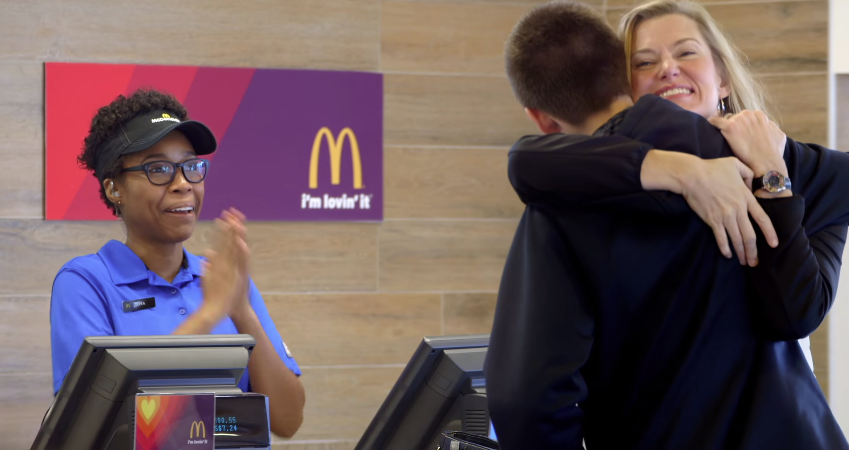
Ace Metrix via Forbes CMO Network
McDonald’s strutted some serious creative prowess, departing from its de rigueur strategies of enticing food images and reliance on the Ronald McDonald character to appeal to consumers on an emotional and personal level this Super Bowl. Its “Pay With Lovin’” Super Bowl ad achieved one of the highest Super Bowl Ace Scores of all time (706) and was 21% above the category norm for Quick Service Restaurants. It was able to grab viewers’ attention while also informing them about an innovative promotion with a unique “customer feel-good moment” as the end-game—not a McDonald’s sale.
To demonstrate just how successful this ad was, only .06% of ads exceed an Ace Score 700. In the last six years, only Microsoft’s 2014 Super Bowl ad “Empowering” exceeded it with an Ace Score of 710. It’s safe to say that this was McDonald’s most successful ad of the last decade. McDonald’s did a great job of leveraging the Super Bowl’s massive reach through reminders of the McDonald’s experience, the importance of kindness, family, doing good, etc. In fact, while the Top 10 ads were truly excellent, 75% of the ads that ran in this year’s Super Bowl were overachievers in their respective categories, which is a really good thing since the rates are so expensive. You don’t want to perform below average—or even average—when stakes and expectations are so high.
In today’s highly cluttered media environment, where consumers are increasingly inclined and enabled to avoid ads, it’s key to find ways to get them to actually want to stop and watch your ad. And, it is well-established that a powerful driver of success in this regard is the ability to emotionally penetrate viewers’ hearts and minds. Not only does McDonald’s accomplish this in spades, it does it in a way that taps the powerful emotions inherent in the durable love of family/friends and implicitly (yet legitimately) connects that emotion with the long-term presence the McDonald’s brand has had in each of our lives and communities.
Said one viewer, “I love this commercial. It touched my heart. McDonald’s shocked me by what they are doing. Good ad!”
This trend of positivity was seen with many other top-scoring Super Bowl advertisers this year. For the past few years, we’ve seen a pivotal shift away from sheer shock value and slapstick humor toward emotional connectivity in Super Bowl ads. Nearly every ad in the Top 10 embraced this emotional connection with the exception of Doritos and Snickers, which won on humor, attention, likeability and desire.
Top 10 Super Bowl Ads 2015

*Definition: The Ace Score is the measure of ad creative effectiveness based on viewer reaction to national TV ads. A unique sample of 500+ people, representative of the U.S. TV viewing audience scores each ad. The results are presented on a scale of 1–950, which represents scoring on creative attributes such as Persuasion, Likeability, Information, Attention, Change, Relevance, Desire and Watchability. This list represents the top 10 Super Bowl XLIX ads by Ace Score. The list is based on ads to have debuted during the beginning of Super Bowl game play through the final whistle on February 2, 2015. To be considered for the top 10 list, an ad must have achieved the minimum Attention threshold.
In keeping with its trend toward pulling at heartstrings, Budweiser ’s “Lost Dog” ad scored an admirable 652 Ace Score (34 percent above the Beer ad average).
One 50+ Male commented: “Best ad I have seen in a long time! Kept my attention. I got choked up by the end of it. You made a grown man cry.”
Coca-Cola’s “#MakeItHappy” ad, which tackled cyber-bulling, similarly appealed to consumers on an emotional level, tying with both Budweiser and Snickers with an Ace Score of 652.
One female, 21-35 years-old said this about the ad: “I LOVED what Coca-Cola did with this message. This is such an important message, and so many people have been misusing the Internet as a place to be cruel to one another. The message from Coke about ‘sharing the love’ and being kind is a great example of the positive messages that people need to hear today. Great job!”
Mercedes-Benz very effectively combined positivity and a little humor with its “Fable” ad appearing in Q4, which achieved an Ace Score of 649. The ad, which won on Attention, Likeability—and Emotion—was Mercedes’ best Super Bowl effort in six years, effectively weaving their product into the compelling, iconic modern day “Tortoise and Hare” tale.
A 50+ female commented: “I loved the animation. The hare selfie is adorable. The speed of the Mercedes is very appropriately presented. It’s all great!”
Last year’s Super Bowl winner Microsoft had an impressive showing this year, as well, with its “Braylon O’Neil” ad, which achieved an Ace Score of 646 and 6th position on the entire list. Right behind it was Dodge’s “Wisdom” ad, which achieved an Ace Score of 644.
Always’ Super Bowl debut “Like a Girl,” which aired during half time, was extremely well-liked by consumers, achieving an impressive Ace Score of 636.
This ad appealed to men just us much as women. Said one 36-49 year-old man, “I love the empowerment of girls. I have nieces and sisters that need to stay strong. Thanks.”
The trend toward meaningful, respectful messages to consumers seems to be working. Bottom line: It’s a tough world out there, and if advertisers expect consumers to sit up and take notice of their ads, they need to respect their intelligence, give them a bit of an escape, and give them something to think about and talk about.
To read the original article, visit Forbes.